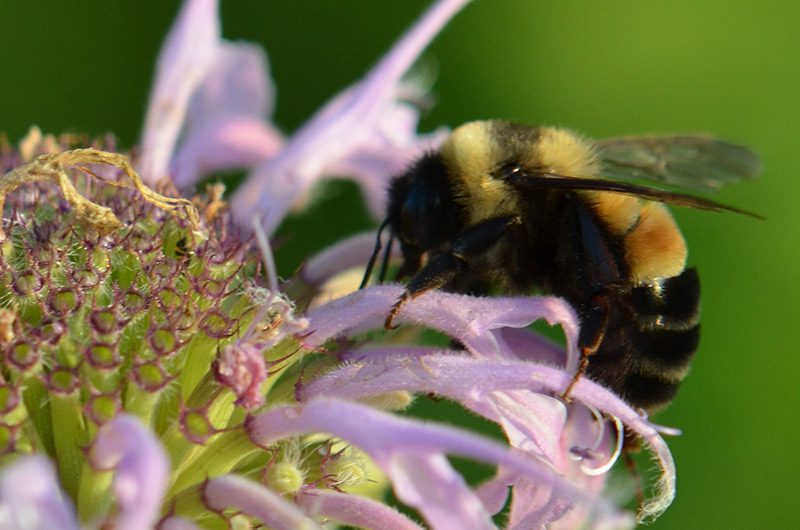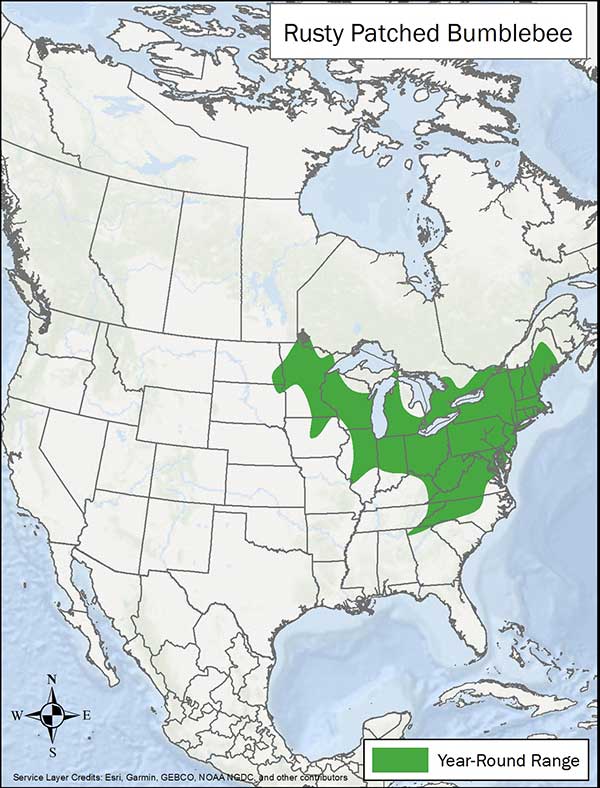LandPKS Learning
Habitat Hub

Rusty Patched Bumble Bee
These bees are unique among other North American bumble bees in that the queen’s color pattern differs from that of the worker bees in the colony. The rusty patched bumble bee queen does not have a rusty patch.
Bombus affinis
Identification
Rusty patched bumble bees have a rusty (brown or orange) patch on the second part of their abdomen. The rear of the second segment of their abdomen has entirely yellow hair, and the third and all proceeding segments of the abdomen are covered with black hair. They can also be identified by their thumb-tack: yellow hairs on the thorax with a T-shaped area of black hairs, with the top part of the T stretching between the wings, and a thin line extending down the middle towards the back of the thorax. Size is variable within bumble bee species, but the rusty patched bumble bee is generally larger and stouter than the half-black bumble bee. The rusty patched bumble bee is listed as Endangered in the United States and Canada.
Observation Tips
The rusty patched bumble bee’s range is from eastern Canada to the east coast of United States, and parts of the upper Midwest. Much of their prairie and grassland habitat has been lost, degraded, or fragmented. They are often found close to or within woodlands, urban parks, gardens, and in proximity to intensive row crop agriculture. The rusty patched bumble bee emerges early in spring and is one of the last species of bumble bee to go into hibernation. You can share your sightings of bumblebees through bumble bee watch.
Interesting Fact
These bees are unique among other North American bumble bees in that the queen’s color pattern differs from that of the worker bees in the colony. The rusty patched bumble bee queen does not have a rusty patch.
Ideal Habitat
The rusty patched bumble bee prefers grasslands, tallgrass prairie, woodlands, and marshes where flowering plants, nesting sites, and overwintering sites are abundant. Recently, bees have been found in agricultural landscapes and residential parks and gardens. Nesting sites consist of underground and abandoned rodent burrows or clumps of grasses. Bees feed on nectar and pollen of food plants including soapberry, buffaloberry, mints, prairie clovers, sunflowers, honeysuckles, beebalms, prunus trees and shrubs, and goldenrods. They need a consistent and diverse supply of flowers blooming throughout the colony’s life, April through September. Undisturbed soil is required for overwintering queen bees.

Range map provided by International Union for Conservation of Nature
Management Activities that Benefit Species – Best Management Practices (BMPs)
Maintaining or planting abundant nectar and pollen producing native wildflowers is one of the best ways to support native bee populations, especially the rusty patched bumble bee. Native plants that can be planted in home gardens for rusty patched bumble bee include lupine, asters, ninebark, and bee balm. Maintain any remaining intact grasslands, tallgrass prairie, and woodlands.
Management Activities to Avoid
Avoid pesticide or herbicide use in or near rusty patched bumble bee habitat as that could impact the bee and its food plants. Avoid habitat fragmentation and monocropping in areas of known rusty patched bumble bee habitat.
Other Species that Benefit from Similar Habitat Management
Other species that may benefit from habitat management for the rusty patched bumble bee include other North American species of bumblebees, other pollinators, nectar plants, and nectar-feeding species.
Download
Download the Rusty patched bumble bee factsheet
Descarga la ficha de abejorros Bombus affinis
Other Resources
International Union for Conservation of Nature (IUCN). 2019. The IUCN Red List of Threatened Species. Version 2019-3. Rusty patched bumble bee
NatureServe Explorer. 2019. NatureServe Explorer: An online encyclopedia of life [web application]. Version 7.1. NatureServe, Arlington, Virginia. Rusty patched bumble bee
University of Minnesota. 2021. Bee Lab. Rusty patched bumble bee identification
U.S. Fish & Wildlife Service. 2019. Fact Sheet Rusty Patched bumble bee (Bombus affinis)
Bumble Bee Watch. 2020. Community science to track and conserve North America’s bumble bees. Record a sighting.
Photo credit: USFWS Midwest Region/Flickr
Mobile App | Data Portal | Knowledge Hub | Habitat Hub | Learning Collections | Blog | About | Contact | Support



